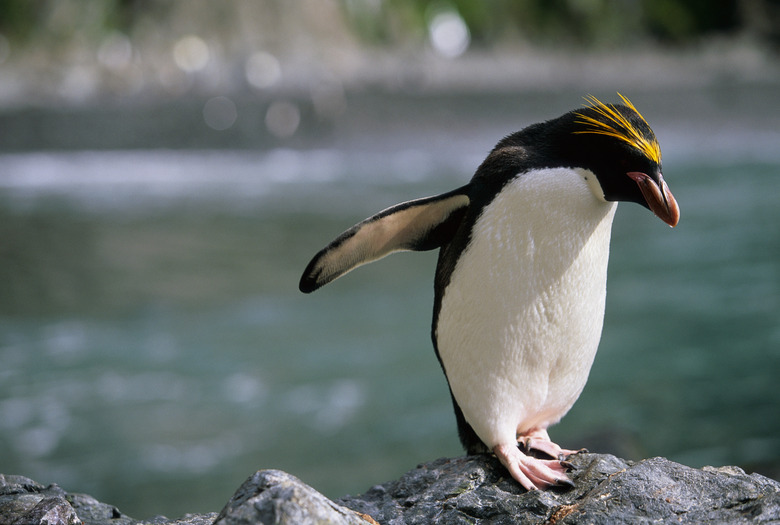Adaptations Of A Macaroni Penguin
The scientific name for the macaroni penguin is Eudyptes chrysolophus. It is found on the Antarctic peninsula and sub-Antarctic Islands. This penguin is also found in the Falkland Islands, Chile, South Georgia and the South Sandwich Islands, Kerguelen Islands, South Shetland Islands, McDonald Islands and Crozet Islands, according to Animal Diversity Web. The macaroni penguin has many adaptations that enable it to survive in a relatively harsh environment.
Physical Adaptations
Physical Adaptations
Macaroni penguins are large for a bird species. Adults measure 20 to 28 inches in length and weigh 11 to 13 lbs. In contrast to flying birds, macaroni penguins have solid bones as opposed to hollow bones. The adaptation of greater bone weight allows for deeper and longer underwater dives, says Animal Diversity Web. Other adaptations that increase swimming ability include webbed feet and a tail that improves steering. While macaroni penguins have poor vision on land, their eyes are adapted for excellent underwater vision. This helps them avoid killer whales and leopard seals, the macaroni penguin's main predators.
Diet Adaptations
Diet Adaptations
These penguins have adapted to feed mostly on krill, small shrimp-like animals. They may travel long distances to reach areas with a high krill population. When krill are scarce, macaroni penguins feed on other crustaceans, fish and squid. During breeding season these birds may fast for up to 40 days. Once the chicks have hatched, food foraging is typically conducted daily.
Communication Adaptations
Communication Adaptations
The macaroni penguin has several adaptations for communication. The bird communicates using behaviors such as head moving and flipper waving, gesturing, bowing and preening, reports Animal Diversity Web. Individual vocalizations are another method of communication.
Reproductive Adaptations
Reproductive Adaptations
Two eggs are typically laid by the female macaroni penguin. The first egg is smaller and less likely to hatch a healthy chick. Therefore, one chick per family is the common configuration. Because the penguins live in a cold environment, proper incubation of the eggs is essential. Both parents follow a strict incubation schedule, where the male and female share the nesting responsibility. Once the chick hatches the male cares for it while the female gathers food.
Cite This Article
MLA
Fielder, Dan. "Adaptations Of A Macaroni Penguin" sciencing.com, https://www.sciencing.com/adaptations-macaroni-penguin-8680731/. 22 November 2019.
APA
Fielder, Dan. (2019, November 22). Adaptations Of A Macaroni Penguin. sciencing.com. Retrieved from https://www.sciencing.com/adaptations-macaroni-penguin-8680731/
Chicago
Fielder, Dan. Adaptations Of A Macaroni Penguin last modified August 30, 2022. https://www.sciencing.com/adaptations-macaroni-penguin-8680731/
